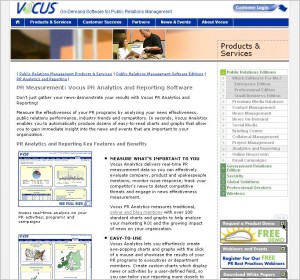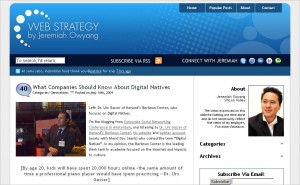In a word: Vocus. I recently took a one-hour tour of this magical kingdom, and left feeling that I could never again be satisfied with ordinary life. While you’re in the Vocus world, it really seems as if you have the entire media establishment of America (and the UK) at your beck and call. Just waiting to hear from you!
Okay, so that part is a fantasy. But what you do have with Vocus is access to a very powerful database of media outlets and contacts, combined with an exceptional toolset (for contact management, distribution, etc.), and accessed through a user-friendly, virtually seamless interface. It’s on-demand online, so no infrastructure or upkeep is required.
All this comes at a price, of course, but not actually an outrageous price. And it has the potential to pay for itself. First, the built-in reports and analytical tools could be a big help in terms of tracking and justifying the PR budget-including social media investment. And second, the time savings, plus improved targeting, could definitely improve PR ROI.
On top of that, Vocus provides comprehensive capabilities for monitoring what’s being said about your company. The need to see media trends and manage PR issues in nearly real time has by now become more than obvious.
But before I begin to sound like an advertisement, I should say there are other products that do each of these things, and there may be one or more that does them all–I didn’t research the whole space. And your company may already be doing a great job of coordinating these factors in-house. The point is not how it’s getting done, but whether it’s getting done. And my Vocus tour was a strong reminder that every company needs to have a strategic plan for creating PR and a tactical plan for measuring the result.
If it sounds like this line of thought applies to something that happens in other departments (or on another planet), consider that a warning signal. Treating PR and HR as separate worlds is one of the root causes for weak employer branding. As an exercise on this point, look at two questions:
1. “What are consumers thinking and saying about our company’s product/service?”
2. “What are high-value candidates thinking and saying about our company as a place to work?”
Not the same! Of course there’s some overlap, but measuring 1 doesn’t tell you anything about 2. And if there is a problem in the area of 2, it won’t be solved by fixes applied to 1. Et cetera.
There’s plenty of advice out there on building the employer brand. (Browse this interesting white paper on the topic from the Human Capital Institute.) But let’s say your company has developed a good employer brand. How do you promote the brand effectively? Not so much advice available on this topic.
Presenting effectively on the corporate website is a key component, needless to say. There’s a lot more to it, though. So I rummaged around a bit, and the best thing I found was an old article (1998!) from the always-ahead-of-the-curve Dr. John Sullivan. Seems like it could have been written tomorrow . . .



